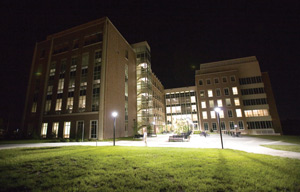|
|
New Research Buildings Promote Biotech Boomdownloadable pdf
The university has opened the first two of a new generation of research buildings on campus that Vice President for Research Win Phillips said “will be a cornerstone of UF’s future in research, helping to attract and facilitate the work of world-leading faculty.” On Nov. 15, officials dedicated the Cancer and Genetics Research Complex and the Center of Excellence for Regenerative Health Biotechnology. “From cancer and genetics to nanoscience and from basic biological sciences to emerging pathogens, UF will be at the forefront and have forward-looking programs to conduct cutting-edge research,” Phillips said. Gov. Jeb Bush helped dedicate the $84.5 million facility that integrates much of the university’s cancer and genetics research. The 280,000-square-foot complex is the largest research building on campus. A five-story research wing of the UF Shands Cancer Center and a six-story Genetics Institute wing are contained in the facility. Also included are the Interdisciplinary Center for Biotechnology Research, which provides support services to scientists, and the C.A. Pound Human Identification Laboratory, a premiere forensic anthropology laboratory. “We are truly in the midst of a renaissance of our research building infrastructure,” said Phillips, adding that planning is also under way for three buildings devoted to research in nanotechnology, biomedical sciences and emerging pathogens. “We expect that by around summer 2009 we will have added about 600,000 square feet of research space to our campus.” The Cancer and Genetics Research Complex is designed to maximize collaborations among different groups of researchers and to convert scientific ideas into innovative cancer therapies and other beneficial technologies. “We think this building — pairing genetic researchers with cancer researchers, people who work on human health, people who work with plants, people who are investigating the mechanisms of life itself — is the essence of collaboration,” said Dr. Douglas Barrett, senior vice president for health affairs. The Center of Excellence for Regenerative Health Biotechnology (CERHB) has 46,000 square feet of educational, research and manufacturing facilities in Progress Corporate Park in Alachua. CERHB was established in 2003 to stimulate promising research and facilitate commercialization of technologies that will provide treatments and cures for human diseases, as well as create new companies and high-wage jobs for Florida. “The CERHB is working to develop a biotechnology cluster in Florida by stimulating new company formation and existing company expansion, and by attracting outside companies to the region,” said center Director Richard Snyder. The launch of CERHB activities required construction of a sophisticated FDA-compliant manufacturing facility, as well as education and research facilities. Using a $10 million state grant and additional funds from the U.S. Department of Commerce Economic Development Agency and the university, the center purchased two buildings at the research park and began renovation. The Education and Research building was completed in late 2004, and the manufacturing facility was completed in August 2006. These facilities support two primary CERHB initiatives: the expansion of clinical biopharmaceutical manufacturing capacity and implementation of industry-based training programs. The rapid clinical testing and development of new treatments, known as biologics, is facilitated by having access to federally compliant manufacturing facilities. Providing biologics manufacturing capacity in Florida that ensures access and reasonable prices for university researchers and biotechnology companies in the Southeast greatly enhances drug and industry development in the region. The new CERHB drug development facility, Florida Biologix™, offers a wide range of biopharmaceutical development and manufacturing services to the bio- technology industry and to biomedical research institutions. As Florida’s biotechnology industry adds a manufacturing component to its already-strong research and development, the need for a skilled workforce will grow. The CERHB has formed strategic partnerships with corporations, state and local government agencies, and educational institutions to train faculty and deliver curricula to attract and educate high school and college students, as well as provide existing workforce training for entry and mid-level careers in the biotechnology industry. Joseph Kays |

